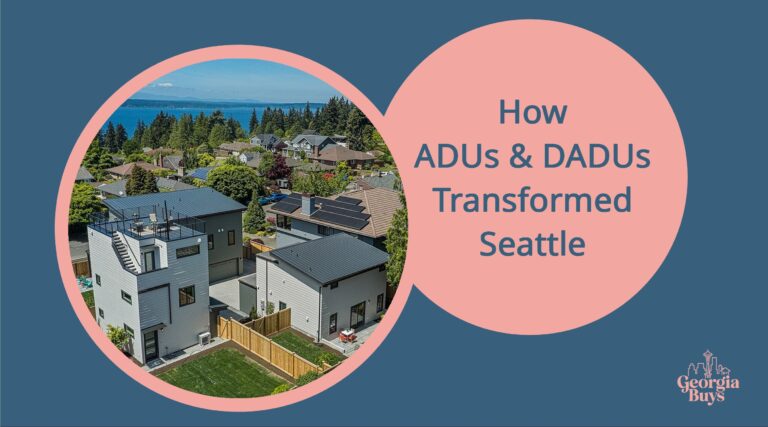
If you’ve lived in Seattle for a while, I’m sure you’ve sensed some changes. Seattle has gone through big changes in the last ten years. It hasn’t been loud or flashy, but it has changed the way people live in neighborhoods all throughout the city. Before these changes, many single-family lots had only one home and very little flexibility for adding more.
In 2019, city leaders passed a new law that made it much easier for people to build accessory dwelling units (ADUs) and detached accessory dwelling units (DADUs), also called backyard cottages. These small homes have made it possible for families to live together in new ways, for neighborhoods to grow without losing their character, and for more housing to be added without big apartment buildings. They have given homeowners more freedom, renters more options, and the city a path to add much-needed housing gradually instead of through large new developments.
In July of 2019, the Seattle City Council passed Council Bill 119544. This new law made several important changes:
City leaders wanted to help solve problems like rising housing costs and a lack of available inventory for homes. They believed that adding more housing gently, by using space that already exists, it would keep neighborhoods strong while giving more people a place to live.
Wondering if your property has room for an ADU or DADU? Let us help you explore your options and show you how adding one could boost your property’s value.
These changes worked faster than many expected. Seattle issued 286 ADU permits in 2019, then 502 in 2020. In 2021 that number jumped to around 800, and by 2022 the city reached 988 permits. That is almost four times as many as in 2018. (Data Smart Cities)
Even though Seattle only has about 20% of the region’s population, it made up 62% of all ADU permit applications in 2022. (cotta.ge) This has made Seattle one of the leading cities in the country for small-scale housing.
More Homes on One Lot:
By 2022, Seattle was building more ADUs than new single-family houses. (Cato Institute) Some owners even build two ADUs, such as a basement unit and a backyard cottage, making their property feel like a small triplex.
New Ways to Live:
ADUs are not just rental units. Families use them for grandparents, college-aged kids, or caregivers. Nonprofits like The BLOCK Project build small homes in backyards for people who need a safe place to live while they get back on their feet.
Lower Costs and Fairness Concerns:
Data from Mayor Harrell’s office shows that ADUs rent for about 25% less than similar apartments. Condo ADUs often sell for 40% less than main homes. But most ADUs are still built in wealthier areas. In 2022, almost 30% of new permits were in neighborhoods with median income over $135,000. (Capitol Hill Seattle)
Even with these changes, there are still problems:
Seattle leaders are still working to make building easier. In 2024, Mayor Harrell suggested new ideas:
Seattle also created the ADUniverse Portal. This online tool helps homeowners see what is possible on their own property and make getting pre-approved ADU designs much more efficient. On a larger scale, the state of Washington passed House Bill 1337 to make ADU-friendly rules apply everywhere.
Curious how much value a backyard cottage could add to your home? Reach out today and we can walk you through the potential on your lot
| Metric | Outcome |
|---|---|
| ADU Permits | Quadrupled since 2018; nearly 1,000 in 2022 |
| Built Units | About 37% of permitted units are complete |
| Affordability | ADU rents ~25% lower; ADU condos ~40% less |
| Equity | Most permits are in high-income areas |
| Community Concerns | Financing, neighborhood character, condo sales |
At Georgia Buys, we have been right in the middle of Seattle’s ADU boom since the beginning. Our team has worked side by side with builders, homeowners, and designers since the 2019 legislation was signed into law; in fact, we were one of the first to navigate through this emerging architecture.
We have seen how these small homes can create more affordable living options and we understand the zoning rules that make or break a project. We know how to spot when a lot truly has ADU potential, and we will be honest with you about whether your property is in the right zoning or has enough lot coverage left to make building an ADU worth it. That experience and straightforward guidance is why so many homeowners turn to us as a trusted resource.
Seattle’s 2019 ADU law shows how small changes can make a big difference. By letting homeowners add cottages and basement apartments, the city is adding housing while keeping the feel of its neighborhoods. There are still challenges like costs and fair access, but progress is clear. Take a quick drive around your Seattle neighborhood and I’ll bet you’ll start spotting these ADUs in unexpected places!
If you are thinking about an ADU or DADU on your property, visit Seattle’s ADUniverse toolkit and call our team of ADU experts to learn more. Your backyard might be the key to creating more homes in your community.